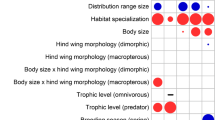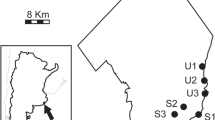Abstract
We investigated some of the causes of ground beetle decline using atlas data from Belgium, Denmark and the Netherlands, countries in which natural environments have all but disappeared. We used ordinal regression to identify characteristics that are significantly correlated with the decline of carabid beetle species over the last 50–100 years, using a stepwise selection procedure to select the optimal model according to the Akaike Information Criterion. The results showed that large-bodied carabid populations have declined more than smaller ones, possibly because of their lower reproductive output and lower powers of dispersal. Habitat specialist populations (i.e. species with small niche breadths) have also decreased more than habitat generalist populations. Species with both long- and short-winged individuals have been less prone to decline than those that are exclusively either short-winged or long-winged. Dimorphic species may survive better in highly altered environments because long-winged individuals are good at dispersing between suitable habitats and short-winged individuals are good at surviving and reproducing in these newly colonised habitats. Finally, populations of large carabids associated with coastal, woodland or riparian habitat types were less prone to decline than populations of large carabids associated with various, open or grassland habitat types. The pattern is reversed for carabid species smaller than 8 mm in size. These results are explained in the context of habitat restoration and destruction in these highly modified western European countries.



Similar content being viewed by others
References
Akaike H (1973) Information theory and an extension of the maximum likelihood principle. In: Petrov BN, Csake F (eds) Second International Symposium on Information Theory. Akademiai Kiado, Budapest, pp 267–281
Anonymous (2000) World resources 2000–2001: people and ecosystems. United Nations Development Programme. Elsevier, Amsterdam
Assmann T (1999) The ground beetle fauna of ancient and recent woodlands in the lowlands of north-west Germany (Coleoptera, Carabidae). Biodivers Conserv 8:1499–1517
Bangsholt F (1983) Sandspringernes og Løbebillernes Udbredelse og Forekomst i Denmark ca. 1830–1981 (Coleoptera: Cicindelidae and Carabidae) (in Danish). Dansk faunistik Bibliotek 4. Scandinavian Science, Copenhagen
Baur B, Schmid B (1996) Spatial and temporal patterns of genetic diversity within species. In: Gaston K (ed) Biodiversity—a biology of numbers and difference. Blackwell, Oxford, pp 169–201
Beissinger SR (2000) Ecological mechanisms of extinction. Proc Natl Acad Sci USA 97:11688–11689
Blake S, Foster GN, Eyre MD, Luff ML (1994) Effects of habitat type and grassland management practices on the body size distribution of carabid beetles. Pedobiologia 38:502–512
Brändle M, Stadler J, Brandl R (2000) Body size and host range in European Heteroptera. Ecography 23:139–147
Burel F (1989) Landscape structure effects on carabid beetles spatial patterns in western France. Landscape Ecol 2:215–226
Davies KF, Margules CR, Lawrence JF (2000) Which traits of species predict population declines in experimental forest fragments? Ecology 81:1450–1461
Den Boer PJ (1970) On the significance of dispersal power for populations of carabid beetles (Coleoptera: Carabidae). Oecologia 4:1–28
Den Boer PJ (1986) Carabids as objects of study. In: Den Boer PJ, Luff ML, Mossakowski D, Weber F (eds) Carabid beetles. Their adaptations and dynamics. Fisher, Stuttgart, pp 539–551
Den Boer PJ (1990) The survival value of dispersal in terrestrial arthropods. Biol Conserv 54:175–192
Den Boer PJ, Van Huizen THP, Den Boer-Daanje W, Aukema B, Den Bieman CFM (1980) Wing polymorphism and dimorphism in ground beetles as stages in an evolutionary process (Coleoptera: Carabidae). Entomol General 6:107–134
Desender K (1986) Distribution and ecology of carabid beetles in Belgium (Coleoptera, Carabidae), parts 1–4. Institut Royal des Sciences Naturelles de Belgique. Documents de Travail 26:1–30, 27:1–24, 30:1–23, 34:1–48
Desender K (1989) Heritability of wing development and body size in a carabid beetle, Pogonus chalceus MARSHAM, and its evolutionary significance. Oecologia 78:513–520
Desender K (2000) Flight muscle development and dispersal in the life cycle of carabid beetles: patterns and processes. Entomologie 70:13–31
Desender K, Turin H (1989) Loss of habitat and changes in the composition of the ground and tiger beetles fauna in four West European countries since 1950 (Coleoptera: Carabidae, Cicindelidae). Biol Conserv 48:277–294
Desender K, Maelfait JP, Baert L (1991) Monitoring carabid beetles in Belgian coastal dunes. Proceedings of the 4th ECE/XIII, SIEEC, Gödöllö, pp 153–158
De Vries HH (1996) Metapopulation structure of Pterostichus lepidus and Olisthopus rotundatus on heathland in the Netherlands: the results from transplant experiments. Ann Zool Fenn 33:77–84
Dufrêne M, Legendre P (1997) Species assemblages and indicator species: the need for a flexible asymmetrical approach. Ecol Monogr 67:345–366
FAO (2002) Food and Agriculture Organization of the United Nations. http://apps.fao.org/
Gaston KJ (1994) Rarity. Chapman and Hall, London
Gaston KJ, Blackburn TM (1995) Birds, body size and the threat of extinction. Philos Trans R Soc Lond B 347:205–212
Gaston KJ, Blackburn TM (1996) Conservation implications of geographic range size-body size relationships. Conserv Biol 10:638–646
Grüm L (1984) Carabid fecundity as affected by extrinsic and intrinsic factors. Oecologia 65:114–121
Haeck J (1971) The immigration and settlement of carabids in the new Ijsselmeerpolders. In: Den Boer PJ (ed) Dispersal and dispersal power of carabid beetles. Miscellaneous Papers 8. Landbouwhogeschool Wageningen, The Netherlands, pp 33–52
Harvey PH, Pagel MD (1991) The comparative method in evolutionary ecology. Oxford University Press, Oxford
Heino M, Hanski I (2001) Evolution of migration rate in a spatially realistic metapopulation model. Am Nat 157:495–511
Hengeveld R (1985) Dynamics of Dutch beetle species during the twentieth century (Coleoptera, Carabidae). J Biogeogr 12:389–411
Hengeveld R, Haeck J (1982) The distribution of abundance. I. Measurements. J Biogeogr 9:303–316
Huk T, Kühne B (2000) Egg laying strategy and aspects of larval biology of two Carabus species (Coloeptera, Carabidae). In: Brandmayr P, Lövei G, Brandmayr TZ, Casale A, Taglianti AV (eds) Natural history and applied ecology of carabid beetles. Proceedings of the IX European Carabidologists' Meeting (26–31 July 1998, Camigliatello, Cosenza, Italy). Pensoft, Sofia, pp 161–168
Huusela-Veistola E (1996) Effects of pesticide use and cultivation techniques on ground beetles (Col., Carabidae) in cereal fields. Ann Zool Fenn 33:197–205
Janzen DH (1986) The eternal external threat. In: Soulé ME (ed) Conservation biology: the science of scarcity and diversity. Sinauer, Sunderland, Mass., pp 286–303
Langellotto GA, Denno RF (2001) Benefits of dispersal in patchy environments: mate location by males of a wing-dimorphic insect. Ecology 82:1870–1878
Lawton JH (1995) Population dynamic principles. In: Lawton JH, May RM (eds) Extinction rates. Oxford University Press, Oxford, pp 147–163
Lawton JH, May RM (eds) (1995) Extinction rates. Oxford University Press, Oxford
Lindroth CH (1985–86) The Carabidae (Coleoptera) of Fennoscandia and Denmark. Fauna Entomologica Scandinavica 15, parts 1 and 2. Scandinavian Science, Copenhagen
Lindroth CH (1992) Ground beetles (Carabidae) of Fennoscandia. A zoogeographical study, part III. Smithsonian Institute Libraries, Washington, D.C.
Lövei GL, Sunderland KD (1996) Ecology and behavior of ground beetles (Coleoptera: Carabidae). Annu Rev Entomol 41:231–256
Maddison DR, Baker MD, Ober KA (1999) Phylogeny of carabid beetles as inferred from 18S ribosomal DNA (Coleoptera: Carabidae). Syst Entomol 24:103–138
McCullagh P, Nelder JA (1989) Generalized linear models, 2nd edn. Chapman and Hall, London
McKinney ML (1997) Extinction vulnerability and selectivity: combining ecological and paleontological views. Annu Rev Ecol Syst 28:495–516
Moyle B (2000) Identifying the ecological correlates of extinction-prone species: a case study of New Zealand birds. In: Ferson S, Burgman M (eds) Quantitative methods for conservation biology. Springer, Berlin Heidelberg New York, pp 27–38
Myers N, Mittermeier RA, Mittermeier CG, da Fonseca GAB, Kent J (2000) Biodiversity hotspots for conservation priorities. Nature 403:853–858
Niemelä J (2001) Carabid beetles (Coleoptera, Carabidae) and habitat fragmentation: a review. Eur J Entomol 98:127–132z
Niemelä J, Spence JR (1991) Distribution and abundance of an exotic ground-beetle (Carabidae): a test of community impact. Oikos 62:351–359
Niemelä J, Spence JR (1999) Dynamics of local expansion by an introduced species: Pterostichus melanarius Ill. (Coleoptera, Carabidae) in Alberta, Canada. Div Distr 5:121–127
Pimm SL (1991) The Balance of Nature? Ecological issues in the conservation of species and communities. University of Chicago Press, Chicago
Pimm SL, Raven P (2000) Extinction by numbers. Nature 403:843–845
Pimm SL, Jones HL, Diamond J (1988) On the risk of extinction. Am Nat 132:757–785
Purvis A, Hector A (2000) Getting the measure of biodiversity. Nature 405:212–219
Purvis A, Agapow P-M, Gittleman JL, Mace GM (2000) Nonrandom extinction and the loss of evolutionary history. Science 288:328–330
Regan HM, Lupia R, Drinnan AN, Burgman MA (2001) The currency and tempo of extinction. Am Nat 157:1–10
Robertson IC (1998) Flight muscle changes in male pine engraver beetles during reproduction: the effects of body size, mating status and breeding failure. Physiol Entomol 23:75–80
Roff DA (1986) The evolution of wing dimorphism in insects. Evolution 40:1009–1020
Roff DA (1990) The evolution of flightlessness in insects. Ecol Appl 60:389–421
Rosenzweig ML (1995) Species diversity in space and time. Cambridge University Press, Cambridge
Simberloff D (1994) The ecology of extinction. Acta Palaeontol Polon 38:159–174
Spence JR (1989) The habitat template and life history strategies of pond skaters (Heteroptera: Gerridae): reproductive potential, phenology, and wing dimorphism. Can Zool 67:2432–2447
Thiele HU (1977) Carabid beetles in their environments. Springer, Berlin Heidelberg New York
Tracy CR, George TL (1992) On the determinants of extinction. Am Nat 139:102–122
Turin H (1990) Checklist of the ground-beetles of the Netherlands (Coleoptera: Carabidae) (in Dutch). Entomol Ber (Amst) 50:61–72
Turin H (2000) De Nederlandse Loopkevers, Verspreiding en Oecologie (Coleoptera: Carabidae). Nederlandse Fauna 3. Nationaal Natuurhistorisch Museum Naturalis, KNNV Uitgeverij and EIS-Nederland, Leiden
Turin H, Den Boer PJ (1988) Changes in the distribution of carabid beetles in the Netherlands since 1880. II. Isolation of habitats and long-term time trends in the occurrence of carabid species with different powers of dispersal (Coleoptera, Carabidae). Biol Conserv 44:179–200
Turin H, Peters H (1986) Changes in the distribution of carabid beetles in the Netherlands since about 1880. I. Introduction. In: Den Boer PJ, Luff ML, Mossakowski D, Weber F (eds) Carabid beetles, their adaptations and dynamics. Fischer, New York, pp 489–495
Vepsäläinen K, Spence JR (2000) Generalization in ecology and evolutionary biology: from hypothesis to paradigm. Biol Phil 15:211–238
Vermeulen HJW, Szyszko J, van Dijk ThS (1997) Unoccupied habitat islands: unreachable or unsuitable? In: Cooper A, Power J (eds) Species dispersal and land use processes. IALE, Great Britain, pp 143–148
Acknowledgements
We thank Hans Turin for making selected Dutch data sets available. Jari Niemelä, John Spence, Matti Koivula and two anonymous referees provided constructive criticism of an earlier draft of this paper.
Author information
Authors and Affiliations
Corresponding author
Rights and permissions
About this article
Cite this article
Kotze, D.J., O'Hara, R.B. Species decline—but why? Explanations of carabid beetle (Coleoptera, Carabidae) declines in Europe. Oecologia 135, 138–148 (2003). https://doi.org/10.1007/s00442-002-1174-3
Received:
Accepted:
Published:
Issue Date:
DOI: https://doi.org/10.1007/s00442-002-1174-3




